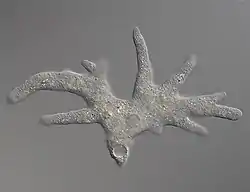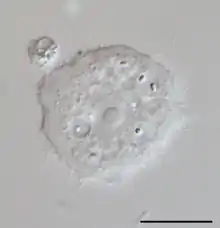Lobosa
Lobosa is a taxonomic group of amoebae in the phylum Amoebozoa. Most lobosans possess broad, bluntly rounded pseudopods, although one genus in the group, the recently discovered Sapocribrum, has slender and threadlike (filose) pseudopodia.[1] In current classification schemes, Lobosa is a subphylum, composed mainly of amoebae that have lobose pseudopods but lack cilia or flagella. [2][3]
| Lobosa | |
|---|---|
 | |
| Amoeba proteus (Tubulinea) | |
| Scientific classification | |
| Domain: | Eukaryota |
| Phylum: | Amoebozoa |
| Subphylum: | Lobosa Carpenter, 1861, em. Cavalier-Smith, 2009 |
| Classes | |
The group was originally proposed in 1861 by William B. Carpenter, who created it as a taxonomic order containing the single family Amoebina.[4] Carpenter's Lobosa consisted of amoeboid organisms whose endoplasm (endosarc) flows into lobe-like "pseudopodian prolongations." This type of pseudopod, which was understood to be typical of the genus Amoeba "and its allies," differed from the filose (thread-like) or reticulose (netlike) pseudopods of the Foraminifera. The name Lobosa was chosen for these amoebae "as expressing the lobe-like character of their pseudopodial extensions".[5]
As currently defined, the subphylum Lobosa includes both shelled (testate) and naked amoebae (gymnamoebae), but excludes some organisms traditionally regarded as "lobosean", such as Pelomyxa and Entamoeba (Amoebozoa) and some Heterolobosea (Excavata).

 Arcella sp. test (Tubulinea)
Arcella sp. test (Tubulinea) Acanthamoeba sp. (Discosea)
Acanthamoeba sp. (Discosea) Thecamoeba sp. (Discosea)
Thecamoeba sp. (Discosea)
References
- Cavalier-Smith, Thomas; Chao, Ema E.; Lewis, Rhodri (2016). "187-gene phylogeny of protozoan phylum Amoebozoa reveals a new class (Cutosea) of deep-branching, ultrastructurally unique, enveloped marine Lobosa and clarifies amoeba evolution". Molecular Phylogenetics and Evolution. 99: 275–296. doi:10.1016/j.ympev.2016.03.023. PMID 27001604.
- Smirnov, Alexey V. (2011). "A Revised Classification of Naked Lobose Amoebae (Amoebozoa: Lobosa)" (PDF). Protist. 162 (4): 545–570. doi:10.1016/j.protis.2011.04.004. PMID 21798804. Archived from the original (PDF) on 2016-03-04.
- Cavalier-Smith, Thomas (2009-02-01). "Megaphylogeny, cell body plans, adaptive zones: causes and timing of eukaryote basal radiations". The Journal of Eukaryotic Microbiology. 56 (1): 26–33. doi:10.1111/j.1550-7408.2008.00373.x. ISSN 1550-7408. PMID 19340985.
- Carpenter, William Benjamin (1861). "On the systematic arrangement of the Rhizopoda". Natural History Review (Dublin and London). 1 (4).
- Carpenter, William Benjamin (1862). Introduction to the Study of the Foraminifera. Ray Society. pp. 16–28.
External links